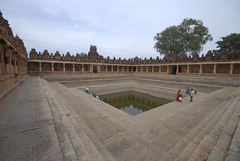 |
| Rajendra Chola being crowned by Lord Shiva, the Cholas were devout shaivaites. |
 |
| Close up of Rajendra Chola I in the above image. Note the exquisite detail. |
Rajendra Chola I, succeeding his father in 1004 C.E. had an
unenviable task: he had to first consolidate the Empire, with the increasing
pressure from the north by the Chauklyas of the Deccan[1], as well internal discontent
from the Pandyas and Cheras. He decided on his full accession in 1004 C.E. to
overthrow the Western Ganga Dynasty[2], who controlled the areas up
bank to the Kaveri, and took over their Capital, Talakkad. After a period of
Consolidation, and Empire Rebuilding, Rajandera Chola set out to make himself
the greatest Chola Emperor.
His eyes first turned to the south of his Empire: Sri Lanka had
been weakened by years of Civil War, and his father, Rajaraja Chola I, had conquered
a significant part of the Kingdom. He decided to finish what his father
started. In 1017, Rajendra Chola led a large army into Anuradhapura and
captured Mahinda's( the then King of Sri-Lanka) crown, queen, daughter, vast amount of wealth and the king
himself whom he took as a prisoner to India.
Next, he set out to quell possible rebellions in the Pandya and
Chera lands; he appointed one of his sons as viceroy with the title Jatavarman
Sundara Chola-Pandya with Madurai as the headquarters. Then he checked the
emerging Chauklyan Power, installing his cousin Rajaraja Narendra[3] as King in Vengi.
On to the Ganges
This is the most
extraordinary Chapter in the History of Cholas; the feat that they may be most
famous for. While fighting the Chauklyas in support of installing Rajaraja
Narendra in Vengi, after defeating the claimant (Vijayaditya), he set out to
punish the Kalinga & Odda (Modern Orissa). Rajendra Chola decided to cam
near the Godavari River, and set out Araiyan Rajarajan, to capture more
territories. Araiyan captured various forts in the way in Modern Madhya
Pradesh, Chattisgarh, Orissa before turning East; He defeated the Pala King
Mahipala I in a pitched battle; then, , Araiyan Rajarajan reached the Ganges
and took some water with him on his journey back, meeting the Chola Emperor at
Godavari, with much pomp and celebration.
He declared himself “Gangaikondacholan”(The Chola who took
the Ganges) and built the new capital of Gangaikandacholapuram, whose magnificence
and brilliance can still be seen now, almost a 1000 years later.
Making of the Chola Lake
 |
| The Cholaganga Tank. |
Rajendra Chola had now brought to the Chola Empire unprecedented
peace and success; by his own control and tributaries, the Chola Controlled
almost all of Peninsular India. At this point, a lesser Emperor would have
settled for this; but not Rajendra Chola. He decided it was time for his Empire
to project its power over the high seas and unto South East Asia. He set out
his army in 1025 C.E. to conquer the South East Asian Empires in Indochina,
subduing the Srivijaya Kingdom of Indochina and the Tambralinga Kingdom of the
Malay Peninsula. The nuances of the involvement can only be talked about in the
larger of Geo-Politics at that point: I am rather diverting myself to concluding
on the Rajendra Chola’s achievement that is, turning the Bay of Bengal into a “Chola
Lake”. This was not a farfetched claim, just looking at Rajandera’s conquests
is enough.
He is one of the greatest monarchs to have reigned in India, and
even in the world, his attempts to project power and influence over seas in the
11th century is more or less unparalleled. Rajendra Chola surpassed
his overachieving father, and took the Chola Dynasty to heights of power it
will never experience later. He helped re-establish the Khmer kingdom, extending
his support to Suryavarman I (some believe that his conquest of Indochina was
meant to help him). When Suryavarman II requested help to build Angkor Wat, and
Rajendra Chola promptly send artisians to build the largest Hindu Temple. He
formalized a system of a panchayats, centralized a tax system and sponsored the
extensive architectural works, and was a patron of the arts.
The Cholas rose to their height of power under Rajandera Chola,
but his death did not end the empire, like so many others; it survived in some
form until 1279 C.E.
Second Part of A three part (?? Maybe more) series: A tribute to
the Cholas.
[1] This
were the western Chaukalyas, who shook of the Rashtrukutas to establish
themselves as an Independent Kingdom in 973 C.E.
[2]
The western Ganga dynsasty ruled over the Kolar-Talakkad Region, near the Kaveri.
[3] A member
of the Eastern Chauklya Dynasty.
Additional Notes
C.E: Common Era.
C.E: Common Era.
References
"The Ocean of Churn:How the Indian Ocean shaped Human History", Sanjeev Sanyal, Penguin Random House, 2016
" A History of South India", KA Nilakanta Sastri, Oxford University Press, 1975
No comments:
Post a Comment